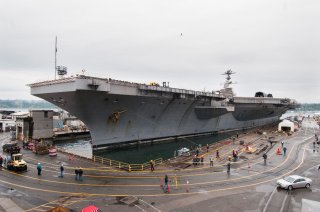Record Number of U.S. Navy Aircraft Carriers at Newport News Shipbuilding
While the fact that six flattops are now in various stages of their lifecycle in Virginia is notable in that efforts are being made to allow the U.S. Navy to maintain its edge, the fact remains that it can barely keep up.
Virginia has long been known as the Old Dominion State, but currently, it could be known as the land of aircraft carriers—as six flattops are in various lifecycle stages at an Atlantic coast shipyard. It is the single most carriers that Huntington Ingalls' (HII) Newport News Shipbuilding has had in its yards in the past three decades.
The former USS Enterprise (CVN-65), the first nuclear-powered aircraft carrier, is awaiting disposal even as the future Ford-class USS Enterprise (CVN-80) is now in the early stages of its construction.
In addition, the Nimitz-class carriers USS George Washington (CVN-73) and USS John C. Stennis (CVN-74) are now in their respective mid-life refueling and complex overhaul (RCOH). CVN-73 had entered Dry Dock #11 in August 2017 and work was expected to be completed by August of last year, but due to the Covid-19 pandemic, it is now on track to return to the sea later this year. CVN-74 is now set to begin its RCOH this year, and that is scheduled to be completed sometime in the mid-2020s.
USS Gerald R. Ford (CVN-78), the lead ship among the U.S. Navy's newest carriers, is currently completing post-sea trials repairs in advance of its maiden deployment later this year; while the next carrier in the class, USS John F. Kennedy (CVN-79) is now in its final construction phase. CVN-79 is slated to be delivered to the Navy in 2024, while the service will next execute the block buy of the future CVN-80 and the next-in-line Ford-class carrier USS Doris Miller (CVN-81).
"I've been there 32 years, I think it's the most we've had because of the [Planned Incremental Availability] with Ford and with the decommissioned hull that's there. So I think that adds two new ships that traditionally would not be there," Brian Fields, HII’s vice president of aircraft carrier construction for CVN-80 and CVN-81, told USNI News earlier this month.
The Cycle of Carrier Life
The activity is especially notable, as the former USS Enterprise was decommissioned in 2017 and the Navy is determining how to best dispose of the service's first nuclear-powered carrier. In addition, CVN-73 is completing her four-year RCOH and will soon become the next of the Navy's flattops to receive upgrades to accommodate the Lockheed Martin F-35 Light II Joint Strike Fighter.
"We've got a lot of work going on in the Norfolk area. We've got George Washington and Stennis in RCOH at Newport News," Rear Adm. James Downey, the program executive officer for aircraft carriers, told reporters last month.
"And Ford, of course … she's wrapping up her first planned incremental availability, that’s her first in service availability following her post delivery test and trials," explained Downey, whose role includes overseeing carriers under construction, in maintenance periods and out for deployment. "And that's being done over at Newport News Shipbuilding as well."
The activity at Newport News Shipbuilding also highlights the fact that the United States now lacks the facilities to keep up with the construction and maintenance the U.S. Navy demands to keep pace with China. The domestic shipbuilding industry has been on the decline since the mid-1990s, and the Navy operates just four public shipyards that can maintain its nuclear-powered fleet—while just around twenty private shipyards are now certified to build and maintain the service's conventionally powered ships.
China, by comparison, operates more than 1,200 shipyards to support the People's Liberation Army Navy as well as its commercial fleet.
While the fact that six flattops are now in various stages of their lifecycle in Virginia is notable in that efforts are being made to allow the U.S. Navy to maintain its edge, the fact remains that it can barely keep up.
Peter Suciu is a Michigan-based writer who has contributed to more than four dozen magazines, newspapers, and websites. He regularly writes about military small arms and is the author of several books on military headgear including A Gallery of Military Headdress, which is available on Amazon.com.
Image: Flickr.

